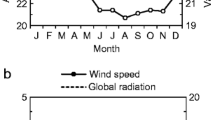Summary
On July 29, 1985, a hot summer day, biometeorological measurements were performed simultaneously in three different urban structures within the city of Munich and in the trunk space of a nearby tall spruce forest. Based on the results of these experiments the following thermophysiologically relevant biometeorological indices were calculated: Predicted mean vote, skin wettedness and physiologically equivalent temperature. These three indices are derived from different models for the human energy balance. They allow the assessment of the thermal components of the microclimates at the selected sites with regard to application in urban planning. The results quantitatively show the great heat stress in the urban structure “street canyon, exposed to south”, whereas in the “trunk space of the tall spruce forest” there is nearly an optimal climate even on hot summer days. Between these extremes the results for “street canyon, exposed to north” show a little higher heat load than for “backyard with trees”.
Zusammenfassung
An einem heißen Sommertag, dem 29. Juli 1985, wurden in drei Stadtstrukturen in München und im Stammraum eines nahegelegenen Fichtenhochwaldes zeitgleich biometeorologische Messungen durchgeführt. Mit den Meßergebnissen wurden folgende thermophysiologisch relevante biometeorologische Indizes berechnet: Predicted mean vote, Hautbenetzungsgrad und physiologisch äquivalente Temperatur. Diese drei Indizes beruhen auf verschiedenen Modellen zur menschlichen Energiebilanz. Mit den drei Indizes wurden die thermischen Komponenten der Mikroklimate an den ausgewählten Meßplätzen im Hinblick auf Stadtplanungsaufgaben bewertet. Die Ergebnisse zeigen quantitativ die relativ große Hitzebelastung bei der Stadtstruktur „Straßenschlucht, nach Süd exponiert“, während im „Stammraum des Fichtenhochwaldes“ selbst an heißen Sommertagen nahezu optimale Bedingungen herrschen. Zwischen diesen Extremen liegen die Ergebnisse für die anderen Meßplätze, wobei für „Straßenschlucht, nach Nord exponiert“ die Wärmebelastung etwas höher als für „Innenhof mit Bäumen“ ist.
Article PDF
Similar content being viewed by others
Avoid common mistakes on your manuscript.
References
Burt, J. E., O'Rourke, P. A., Terjung, W. H., 1982: The relative influence of urban climates on outdoor human energy budgets and skin temperature. II. Man in an urban environment.Int. J. Biometeor. 26, 25–35.
Clarke, J. F., Bach, W., 1971: Comparison of the comfort conditions in different urban and suburban environments.Int. J. Biometeor. 15, 41–54.
DeFreitas, C. R., 1985: Assessment of human bioclimate based on thermal response.Int. J. Biometeor. 29, 97–119.
Fanger, P. O., 1972:Thermal Comfort. Düsseldorf-New York-London: McGraw Hill Book Company.
Gagge, A. P., 1980: The new effective temperatureET *—an index of human adaptation to warm environments. In:Environmental Physiology: Aging, Heat and Altitude. Amsterdam: Elsevier, 59–77.
Gagge, A. P., Stolwijk, J. A. J., Nishi, Y., 1970: An effective temperature scale based on a simple model of human physiological regulator response. ASHRAE Trans.70 (I), 247–257.
Höppe, P., 1984: Die Energiebilanz des Menschen. Wiss. Mitt. Meteor. Inst. Univ. München, Nr. 49.
Höppe, P., Mayer, H., 1987: Planungsrelevante Bewertung der thermischen Komponente des Stadtklimas.Stadt und Landschaft,19.
Jendritzky, G., Nübler, W., 1981: A model analysing the urban thermal environment in physiologically significant terms.Arch. Met. Geoph. Biokl., Ser. B 29, 313–326.
Jendritzky, G., Sönning, W., Swantes, H. J., 1979: Ein objektives Bewertungsverfahren zur Beschreibung des thermischen Milieus in der Stadt- und Landschaftsplanung (Klima-Michel-Modell). ARL Beiträge Nr. 28.
Mayer, H., 1983: STADKLIMA BAYERN, ein anwendungsorientiertes Forschungsvorhaben.Ann. Met. (N. F.) Nr. 2, 24–25.
Mayer, H., Höppe, P., 1984: Die Bedeutung des Waldes für die Erholung aus der Sicht der Humanbioklimatologie.Fortwiss. Centralbl. 102, 125–131.
Morgan, D. L., 1972: Man environment coupling: Physiologic comfort of man in an urban setting. Dissertation, University of California, Davis.
Morgan, D. L., Baskett, R. I., 1974: Comfort of man in the city.Int. J. Biometeor. 18, 184–198.
Stock, P., Beckröge, W., 1985: Klimaanalyse Stadt Essen. KVR.
Author information
Authors and Affiliations
Additional information
With 6 Figures
Rights and permissions
About this article
Cite this article
Mayer, H., Höppe, P. Thermal comfort of man in different urban environments. Theor Appl Climatol 38, 43–49 (1987). https://doi.org/10.1007/BF00866252
Received:
Revised:
Issue Date:
DOI: https://doi.org/10.1007/BF00866252




